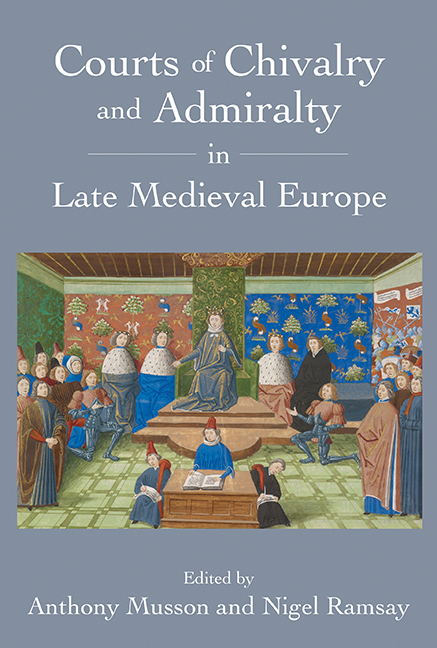Book contents
- Frontmatter
- Contents
- List of Illustrations
- Notes on Contributors
- Preface
- A Note on Editorial Practice
- List of Abbreviations
- Introduction
- Chapter 1 Heralds and the Court of Chivalry: From Collective Memory to Formal Institutions
- Chapter 2 French Armorial Disputes and Controls
- Chapter 3 Art, Objects and Ideas in the Records of the Medieval Court of Chivalry
- Chapter 4 Sir Robert Grosvenor and the Scrope–Grosvenor Controversy
- Chapter 5 From Brittany to the Black Sea: Nicholas Sabraham and English Military Experience in the Fourteenth Century
- Chapter 6 ‘Armed and redy to come to the felde’: Arming for the Judicial Duel in Fifteenth-Century England
- Chapter 7 The Jurisdiction of the Constable and Marshals of France in the Later Middle Ages
- Chapter 8 The Origins and Jurisdiction of the English Court of Admiralty in the Fourteenth Century
- Chapter 9 The Consulate of the Sea and its Fortunes in Late Medieval Mediterranean Countries
- Chapter 10 The Admiralty and Constableship of England in the Later Fifteenth Century: The Operation and Development of these Offices, 1462–85, under Richard, Duke of Gloucester and King of England
- Chapter 11 Some Dubious Beliefs about Medieval Prize Law
- index
Chapter 2 - French Armorial Disputes and Controls
Published online by Cambridge University Press: 28 June 2018
- Frontmatter
- Contents
- List of Illustrations
- Notes on Contributors
- Preface
- A Note on Editorial Practice
- List of Abbreviations
- Introduction
- Chapter 1 Heralds and the Court of Chivalry: From Collective Memory to Formal Institutions
- Chapter 2 French Armorial Disputes and Controls
- Chapter 3 Art, Objects and Ideas in the Records of the Medieval Court of Chivalry
- Chapter 4 Sir Robert Grosvenor and the Scrope–Grosvenor Controversy
- Chapter 5 From Brittany to the Black Sea: Nicholas Sabraham and English Military Experience in the Fourteenth Century
- Chapter 6 ‘Armed and redy to come to the felde’: Arming for the Judicial Duel in Fifteenth-Century England
- Chapter 7 The Jurisdiction of the Constable and Marshals of France in the Later Middle Ages
- Chapter 8 The Origins and Jurisdiction of the English Court of Admiralty in the Fourteenth Century
- Chapter 9 The Consulate of the Sea and its Fortunes in Late Medieval Mediterranean Countries
- Chapter 10 The Admiralty and Constableship of England in the Later Fifteenth Century: The Operation and Development of these Offices, 1462–85, under Richard, Duke of Gloucester and King of England
- Chapter 11 Some Dubious Beliefs about Medieval Prize Law
- index
Summary
Fourteenth- and fifteenth-century sources reveal a strikingly large number of conflicts that resulted from the disputed use of coats of arms. The collection and analysis of these examples allow us to understand the nature of these conflicts and more particularly to see how and by whom these heraldic quarrels could be resolved. These documents call for clarification, to explain, justify or revise the role of certain actors, such as the agents of seigneurial or royal justice, the heralds, and the court of the Marshals, to highlight the social, legal and political stakes that these confrontations then assumed.
The reasons for heraldic disputes in the Middle Ages
The reasons which might give rise in the Middle Ages to a dispute between two physical (individual) or legal persons about heraldic insignia were quite diverse, and their nature and context would often decide the form of resolution that was made.
The first ground of conflict was often the use by two parties of an identical coat of arms, whether intentionally or by accident. But there were other possible causes of the antagonism, in particular the wrongful public display of a coat of arms: either the overstepping of acquired privileges or the enunciation of unsustainable rights and claims; or punitive or defamatory actions against heraldic insignia for some political, military or social reason. Let us consider these different cases.
The use of identical or homonymous coats of arms was a recurrent theme of the various treatises that considered heraldic law – proof that the question remained problematic, as illustrated by several documented heraldic conflicts. This homonymy was, moreover, a consequence of the very principles of the medieval heraldic system.
In the first place, blazon – the set of rules that governs the composition of coats of arms – also includes the very precise design of any heraldic symbol, and in fact multiplies the risk of the same coat of arms being created again and again. Moreover, until the eighteenth century, no Continental European country could claim to maintain an up-to-date and comprehensive catalogue of its existing coats of arms, especially if this stock extended to all social categories.
- Type
- Chapter
- Information
- Courts of Chivalry and Admiralty in Late Medieval Europe , pp. 29 - 46Publisher: Boydell & BrewerPrint publication year: 2018



